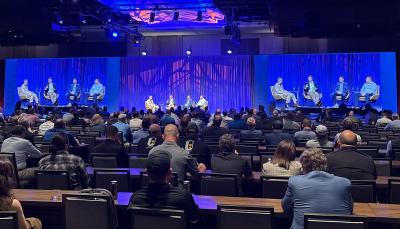- BT revealed it's working on a fascinating new AI use case for emergency services
- Both BT and Uniti, however, said it is a huge pain to work through the API integrations necessary to run AI
- Alianza wants to help solve that problem, but there are still some questions about its approach
NAVIGATE 2025, SALT LAKE CITY, UTAH – In a sea of network optimization tools and call center chatbots, what the BT is doing with AI applications is really special. Well, special enough to make us perk up during the last session of a jam-packed conference day, at least.
Speaking onstage at Alianza’s event, BT Enterprise Voice Director Ed Jakeman explained the company is using AI to provide augmented hearing capabilities for emergency services calls.
What does that mean? Well, when someone calls for help it means the AI can, for instance, detect whether it hears agonal breathing patterns that might be indicative of a cardiac event. That kind of information can help responders make decisions about how to prioritize the emergency calls that come in. The AI can also listen-in to background noise to provide environmental context to responders as they approach the scene of an emergency.
“It’s all about how do we do our absolute best to preserve life and get the emergency services all the information they need,” Jakeman said.
BT is also looking to apply AI to other emergency services use cases, for instance having it answer and categorize calls that come into the non-emergency line so human dispatchers can remain free for more urgent calls.

“We’ve just started the journey with the AI stuff with augmented hearing and AI agents, so we’re just getting into that piece now,” he said.
AI integration headache
According to Jakeman, making these AI applications work on its network isn’t a walk in the park. There is a lot of plumbing that needs to be done to integrate third party components and models.
“All our integration issues were really where we had either third-party applications or internal applications we developed ourselves within BT that we then had to try and fit onto this new platform we were building,” he explained. “It just slowed down our progress. We didn’t get the new platform out as quickly as we’d like.”
Kurt Landgraf, VP of network architecture and engineering at Uniti Group, said his team faced similar integration challenges when the operator was building its own AI tools. He noted Uniti is using AI to analyze network attributes, billing and customer data to deliver predictive agent responses when customers call in about issues.
But he said the integration process to get that kind of a tool to work was a “nightmare.”
Alianza’s angle
This is the problem Alianza is trying to solve with the orchestration layer in its new Intelligent Communications Fabric. Rather operators having to individually tackle a bear of an integration process, Alianza is pitching a future in which it bridges the gap with a single set of APIs that make things easy for both app developers and operators.
Indeed, both Jakeman and Landgraf said a single orchestration layer to do all of this would have made their lives much easier. And less time spent on plumbing means more time can be spent on innovation.
Speaking with conference attendees, Fierce discovered there are a few open questions among customers about how exactly things will work.
Will the APIs Alianza is building be open? How easy will it be to connect Alianza’s fabric to network solutions from other vendors? If operators choose to build their own AI apps using these APIs, who will own the IP? Can operators like BT turn around and sell these apps to peers who are also using Alianza’s fabric?
All of these are valid queries but ones Alianza has time to answer. The company's CTO Dag Peak told Fierce that customers will be able to use the fabric to develop applications “starting next year.” It's initially working on the interworking elements for media and signaling APIs and then will “keep chipping away at the other elements over time.”
“We’re accelerating some developing right now. We’re hiring a bunch of engineers. There’s going to be acquisition involved, there’s going to be some acquisitions that plug some of the capabilities of the ICF – we’ll get a lot of the baseline functionality out next year and then continue to build and build and build,” he concluded.